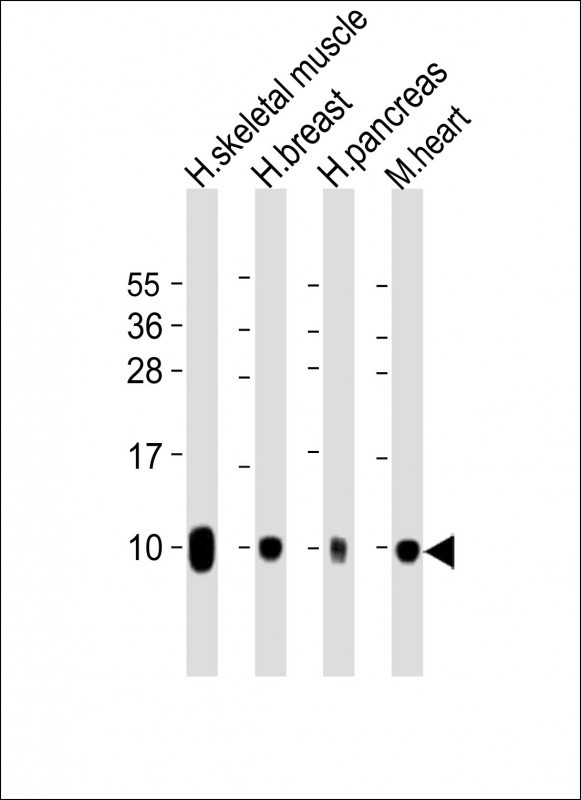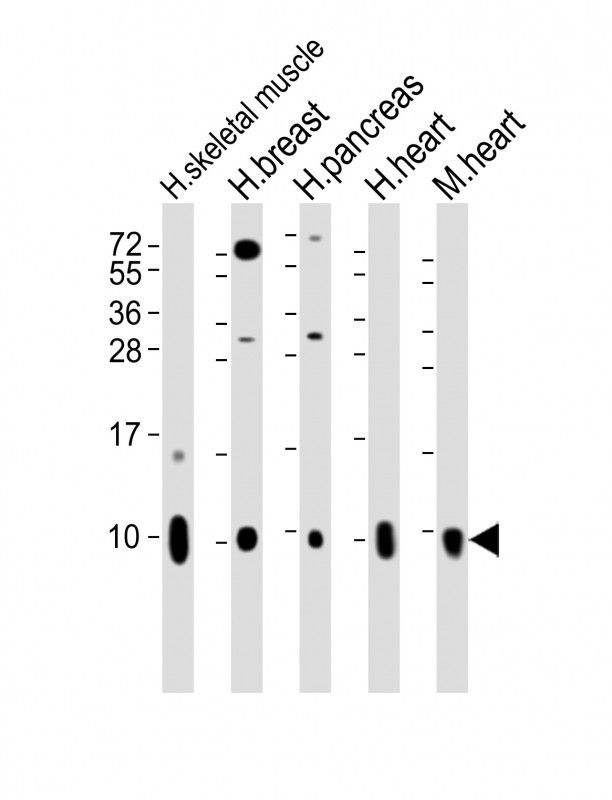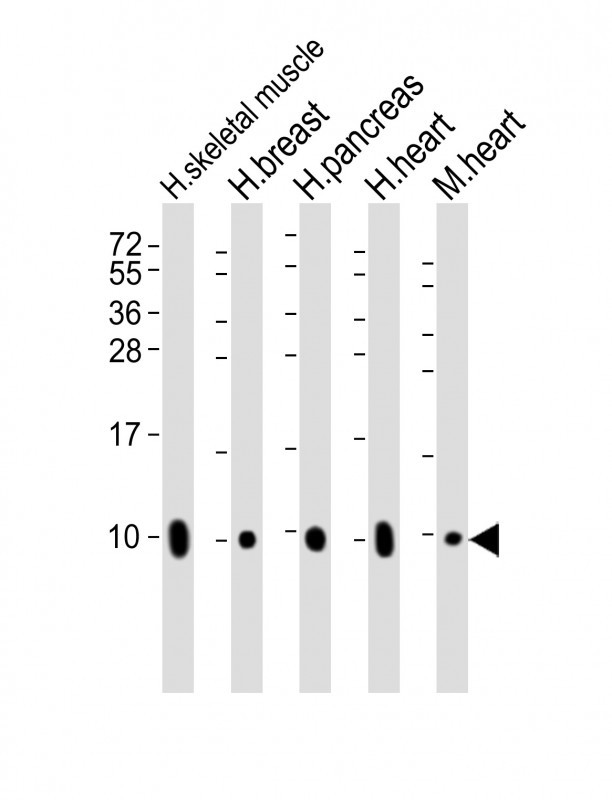COX7A1 Antibody (Center)
Affinity Purified Rabbit Polyclonal Antibody (Pab)
- SPECIFICATION
- CITATIONS
- PROTOCOLS
- BACKGROUND

Application
| WB, E |
|---|---|
| Primary Accession | P24310 |
| Other Accession | NP_001855.1 |
| Reactivity | Human, Mouse |
| Host | Rabbit |
| Clonality | Polyclonal |
| Isotype | Rabbit IgG |
| Calculated MW | 9118 Da |
| Antigen Region | 10-38 aa |
| Gene ID | 1346 |
|---|---|
| Other Names | Cytochrome c oxidase subunit 7A1, mitochondrial, Cytochrome c oxidase subunit VIIa-heart, Cytochrome c oxidase subunit VIIa-H, Cytochrome c oxidase subunit VIIa-muscle, Cytochrome c oxidase subunit VIIa-M, COX7A1, COX7AH |
| Target/Specificity | This COX7A1 antibody is generated from rabbits immunized with a KLH conjugated synthetic peptide between 10-38 amino acids from the Central region of human COX7A1. |
| Dilution | WB~~1:2000 E~~Use at an assay dependent concentration. |
| Format | Purified polyclonal antibody supplied in PBS with 0.09% (W/V) sodium azide. This antibody is purified through a protein A column, followed by peptide affinity purification. |
| Storage | Maintain refrigerated at 2-8°C for up to 2 weeks. For long term storage store at -20°C in small aliquots to prevent freeze-thaw cycles. |
| Precautions | COX7A1 Antibody (Center) is for research use only and not for use in diagnostic or therapeutic procedures. |
| Name | COX7A1 |
|---|---|
| Synonyms | COX7AH |
| Function | Component of the mitochondrial respiratory complex IV (CIV, also named cytochrome c oxidase complex), the last enzyme in the mitochondrial electron transport chain which drives oxidative phosphorylation (By similarity). The CIV complex is the component of the respiratory chain that catalyzes the reduction of oxygen to water (By similarity). Acts as an assembly factor that specifically drives the homodimerization of CIV complexes, mediating the formation of mitochondrial respiratory supercomplexes (respirasomes) containing two CIV: supercomplxes with two molecules of CIV show improved activity (By similarity). Despite being highly expressed in brown adipose tissue, not required for thermogenesis (By similarity). |
| Cellular Location | Mitochondrion inner membrane {ECO:0000250|UniProtKB:P07470}; Single-pass membrane protein {ECO:0000250|UniProtKB:P07470} |

Thousands of laboratories across the world have published research that depended on the performance of antibodies from Abcepta to advance their research. Check out links to articles that cite our products in major peer-reviewed journals, organized by research category.
info@abcepta.com, and receive a free "I Love Antibodies" mug.
Provided below are standard protocols that you may find useful for product applications.
Background
Cytochrome c oxidase (COX), the terminal component of the mitochondrial respiratory chain, catalyzes the electron transfer from reduced cytochrome c to oxygen. This component is a heteromeric complex consisting of 3 catalytic subunits encoded by mitochondrial genes and multiple structural subunits encoded by nuclear genes. The mitochondrially-encoded subunits function in electron transfer, and the nuclear-encoded subunits may function in the regulation and assembly of the complex. This nuclear gene encodes polypeptide 1 (muscle isoform) of subunit VIIa and the polypeptide 1 is present only in muscle tissues. Other polypeptides of subunit VIIa are present in both muscle and nonmuscle tissues, and are encoded by different genes.
References
Bailey, S.D., et al. Diabetes Care (2010) In press :
Talmud, P.J., et al. Am. J. Hum. Genet. 85(5):628-642(2009)
Lazarou, M., et al. FEBS J. 276(22):6701-6713(2009)
Ronn, T., et al. Diabetologia 51(7):1159-1168(2008)
Grimwood, J., et al. Nature 428(6982):529-535(2004)
If you have used an Abcepta product and would like to share how it has performed, please click on the "Submit Review" button and provide the requested information. Our staff will examine and post your review and contact you if needed.
If you have any additional inquiries please email technical services at tech@abcepta.com.













 Foundational characteristics of cancer include proliferation, angiogenesis, migration, evasion of apoptosis, and cellular immortality. Find key markers for these cellular processes and antibodies to detect them.
Foundational characteristics of cancer include proliferation, angiogenesis, migration, evasion of apoptosis, and cellular immortality. Find key markers for these cellular processes and antibodies to detect them. The SUMOplot™ Analysis Program predicts and scores sumoylation sites in your protein. SUMOylation is a post-translational modification involved in various cellular processes, such as nuclear-cytosolic transport, transcriptional regulation, apoptosis, protein stability, response to stress, and progression through the cell cycle.
The SUMOplot™ Analysis Program predicts and scores sumoylation sites in your protein. SUMOylation is a post-translational modification involved in various cellular processes, such as nuclear-cytosolic transport, transcriptional regulation, apoptosis, protein stability, response to stress, and progression through the cell cycle. The Autophagy Receptor Motif Plotter predicts and scores autophagy receptor binding sites in your protein. Identifying proteins connected to this pathway is critical to understanding the role of autophagy in physiological as well as pathological processes such as development, differentiation, neurodegenerative diseases, stress, infection, and cancer.
The Autophagy Receptor Motif Plotter predicts and scores autophagy receptor binding sites in your protein. Identifying proteins connected to this pathway is critical to understanding the role of autophagy in physiological as well as pathological processes such as development, differentiation, neurodegenerative diseases, stress, infection, and cancer.




